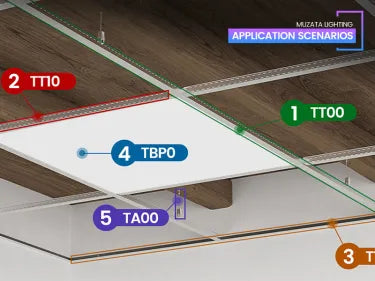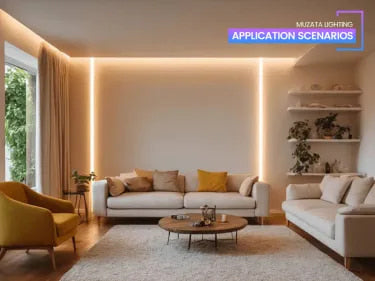TABLE OF CONTENTS
The Complete Guide to Aluminum Channels for Light LED Strips
LED light strips have become an increasingly popular option for lighting in both commercial and residential settings. With their sleek and modern design, energy efficiency, and highly customizable nature, LED strips open up new possibilities for unique and stylish lighting solutions.
One of the most common accessories used with LED strip lights is the aluminum channel, also known as an aluminum profile. But are aluminum channels really necessary for every LED strip installation? In this comprehensive guide, we’ll explore everything you need to know about choosing, installing, and using aluminum channels with your LED strip lighting.
What Are Aluminum Channels for LED Light Strips?

Aluminum channels are long, thin extrusions made from aluminum that are designed to house and mount LED strip lights. The channels have a typical U-shaped profile, with the LED strip installed into the inner groove.
Once installed into the channel, the LED strip light is protected from impact and environmental factors, and the aluminum acts as a heat sink to dissipate heat from the LEDs. An acrylic or polycarbonate lens or diffuser can be installed atop the channel to provide a smooth, finished look and enhance the lighting effects.
How to Cut Aluminum LED Channel
Aluminum Channels Serve Multiple Key Functions:
- Housing and mounting for LED strips - The channel protects the strip and provides an easy installation method.
- Heat dissipation - The aluminum material pulls heat away from the LEDs, preventing overheating.
- Diffuser mounting - The channel securely holds diffusers/lenses to soften and spread the LED light.
- Decorative appearance - Channels look more finished versus an exposed strip.
- Physical protection - Channels protect the LED strip from damage.
- Safety - Channels prevent direct contact with the powered LED strip.
With built-in mounting, heat sinking capabilities, and compatibility with lenses and diffusers, aluminum channels can transform LED strips into durable linear lighting fixtures. But there are some key considerations when deciding whether channels are needed for your unique project.
Are Aluminum Channels Necessary for LED Heat Dissipation?
Early on in the evolution of LED technology, heat management was one of the biggest obstacles to overcome. Unlike incandescent and fluorescent light sources, LEDs are highly sensitive to heat. Excessive heat buildup causes damage and premature failure.
This led to the development of creative thermal management solutions like aluminum heat sinks to maximize surface area for cooling. But over the past decade, improvements in LED chip technology and manufacturing have resulted in LEDs that run cooler and more efficiently than ever before.
Thermal paste or adhesive can be used during installation to optimize contact between the LED strip and installation surface. Additional heat sinking and airflow are not required. The only exceptions are very long run lengths or very tight enclosed spaces with no circulation.
So in most cases, aluminum channels are no longer necessary strictly for thermal performance when using modern, high-quality LED strips. But aluminum’s excellent conductivity still makes it the ideal material for channels to protect and mount LED strips.
LED Diffusers & Light Distribution

While heat dissipation may not require aluminum, the ability to pair LED strips with diffusers makes aluminum channels highly useful. Acrylic or polycarbonate diffuser lenses attach securely into the channels over the LED strips and transform the lighting quality.
Without a diffuser, LED strips emit directional light like spotlights. The bright spots of light can cause discomfort when viewed directly. Diffusers spread and blend the light smoothly, softening shadows and eliminating glare.
Glare is the sensation of visual discomfort when intense light enters the eye. Direct glare occurs when bright light shines directly into the eyes from the light source. This is most problematic with small point light sources. Diffusers enlarge and scatter the light source area to soften direct glare.
Indirect glare occurs when bright light reflects off shiny surfaces like glossy floors or tables. The reflected images can be distracting. Diffusers help prevent both types of glare for superior visual comfort.
Additionally, the diffused lighting effect creates a more uniform appearance, which is desirable for most lighting designs.
Aesthetic Appeal & Practical Benefits
Beyond the technical factors, aluminum channels also provide practical and aesthetic advantages.
First, channels give LED strips a streamlined, integrated appearance. The aluminum housing masks the yellow circuit board, wires, and connectors... everything that detracts from a clean, modern look. The housing also lets you install LED strips flush within surfaces.
Second, channels protect the LED strips from physical damage, dust and grime accumulation, and contact. The closed housing prevents debris build-up on the LEDs which can lead to clogged heat sinks and premature failure. The durable aluminum also protects the LEDs strips from impacts.
Lastly, the channels provide an extra layer of safety when installing LED strips at lower heights. Although LED strips only operate on 12V or 24V DC power, channels can prevent fingers from contacting live parts, especially important for child safety.
So in applications where appearance, protection, and safety matter, aluminum channels solve multiple problems. But are there any downsides to aluminum for LED strip lights?
Downsides of Aluminum Channels
While the benefits are substantial, some drawbacks of aluminum channels should also be considered:
- Added cost – The extruded aluminum channels range from $5-$10per foot depending on the profile dimensions. Acrylic or polycarbonate diffuser materials add another $1.2-$5.5 per foot in cost.
- Light loss – Diffusers absorb/reflect up to 12% of light, reducing brightness versus a bare LED strip.
- Rigidity – The aluminum cannot flex or bend once formed, limiting mounting options.
- Glare reduction – Heavily diffused light may not fully eliminate reflective glare on some glossy surfaces.
- Assembly time – Channels take more time to install cleanly versus a simple LED strip.
- Color temperature shift – Diffusers can slightly reduce color temperature by 150-300K for cool white LEDs.
- Access for maintenance – Channels must be disassembled to access the LED strips for repair.
For most lighting projects, the huge benefits of aluminum channels outweigh the costs and limitations. But for simple hidden installations, the added time and expense may not make sense.
When to Go Without Aluminum Channels
Not every lighting application requires aluminum channels to realize the benefits of LED strips. In general, channels are unnecessary when:
- LEDs are fully hidden from view and glare is not an issue
- Diffused lighting is not important
- Physical protection is not needed
- Easy bending and shaping of the strips is required
- A common example is using LED strips to uplight a ceiling or wall.
Conclusion
In applications where protection, heat dissipation, and glare control are critical, aluminum channels paired with diffusers are a worthwhile investment to create durable, professional LED lighting. For more hidden and basic lighting needs, stripped-down LED strips often suffice. If you have any needs, please contact us.




